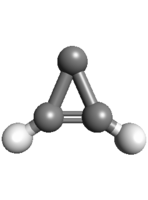Cyclopropenylidene, isotopolog with 13C on C2
 | |
|---|---|
| Species tag | 039510 |
| Version | 1* |
| Date of Entry | June 2012 |
| Contributor | H. S. P. Müller |
|
Please note that this entry deals with the
asymmetric isotopomer with one 13C.
The transition frequencies were largely taken
from | |
| Lines Listed | 4041 |
| Frequency / GHz | < 2471 |
| Max. J | 52 |
| log STR0 | -7.0 |
| log STR1 | -4.5 |
| Isotope Corr. | -1.980 |
| Egy / (cm–1) | 0.0 |
| µa / D | 0.47 |
| µb / D | 3.23 |
| µc / D | |
| A / MHz | 34857.19 |
| B / MHz | 31288.48 |
| C / MHz | 16443.04 |
| Q(300.0) | 13115.1982 |
| Q(225.0) | 8517.6420 |
| Q(150.0) | 4637.2683 |
| Q(75.00) | 1641.7460 |
| Q(37.50) | 582.3759 |
| Q(18.75) | 207.3417 |
| Q(9.375) | 74.3553 |
| Q(5.000) | 29.7017 |
| Q(2.725) | 12.5151 |
| detected in ISM/CSM | yes |